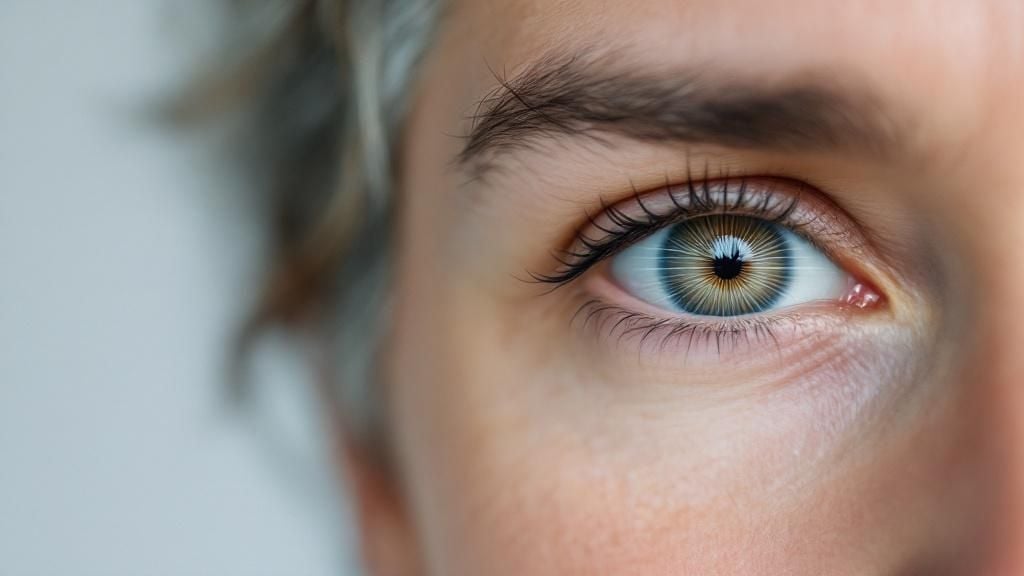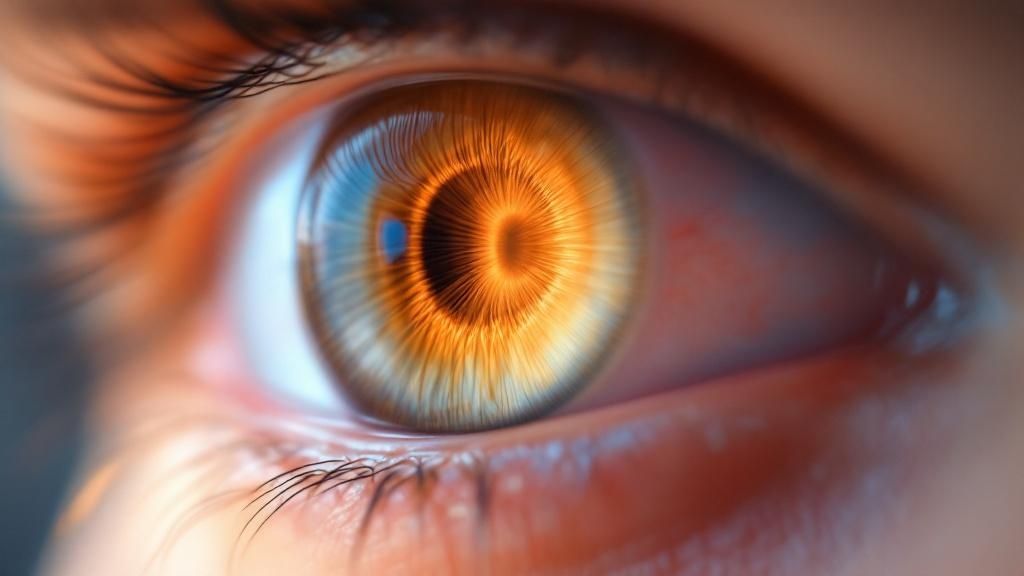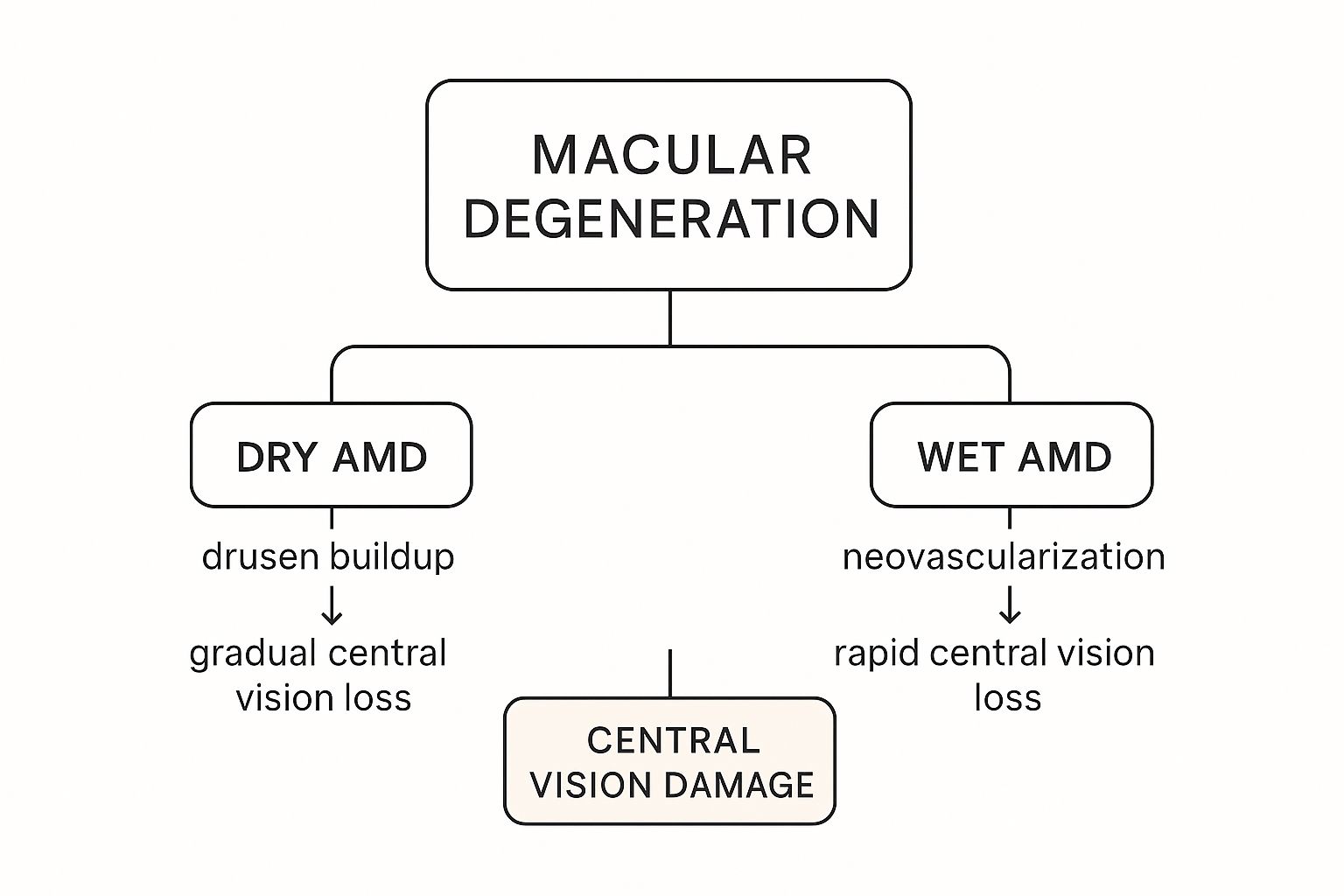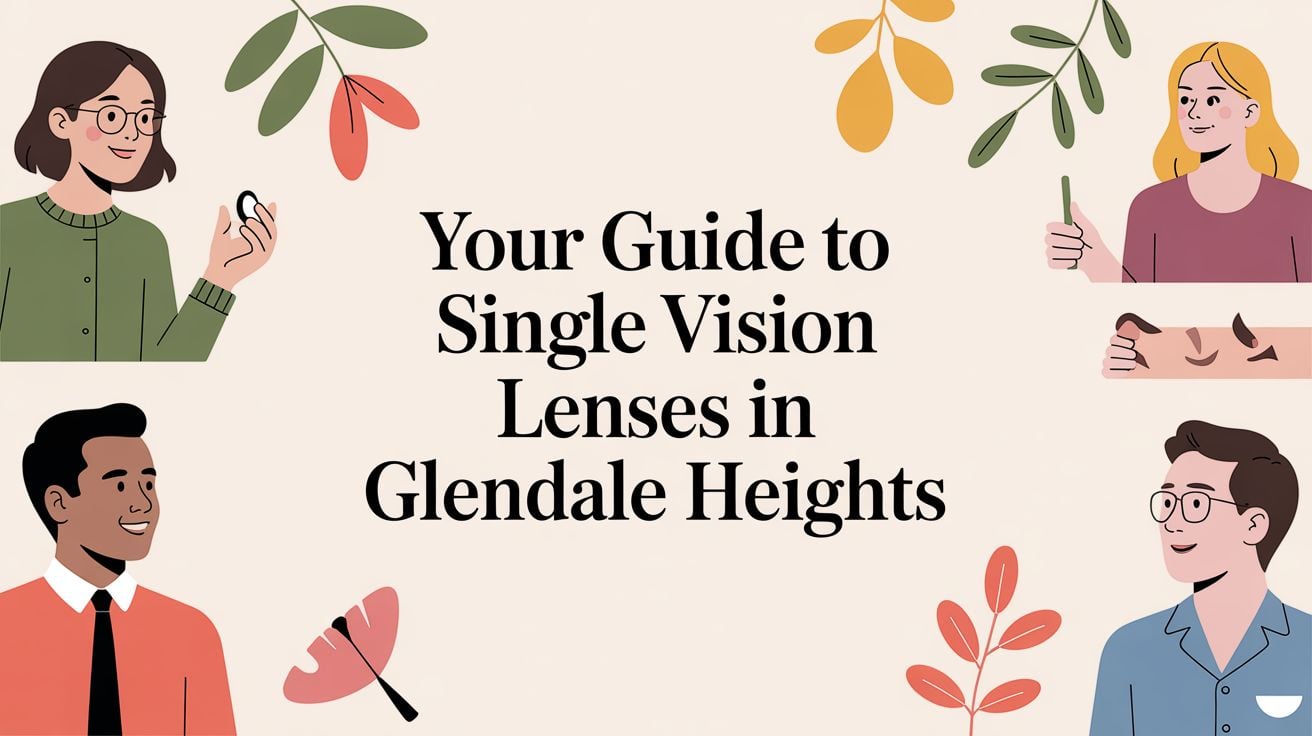If you’ve heard the term “macular degeneration,” it can sound pretty intimidating. Here in Glendale Heights, our goal at iDoctor is to help our community understand what it really means. Essentially, it’s a common eye condition that impacts your central vision—the vision you rely on to see things straight ahead—while leaving your side (or peripheral) vision alone.
It’s a leading cause of vision loss for people over 50, making everyday tasks like reading, driving, or even recognizing a familiar face at a local spot like Camera Park much more difficult. While that sounds serious, the most important thing to remember is that catching it early is the absolute key to managing the condition and protecting your eyesight.
Your Guide to Understanding Macular Degeneration
Think of your eye like a camera. At the back of the camera is a light-sensitive film or sensor—this is your retina. In the very center of that retina is a tiny but incredibly important spot called the macula. This is what gives you your sharp, high-definition central vision.
The macula is what you use to focus on fine details. It’s the part of your eye working overtime when you're reading a book, navigating traffic on North Avenue, or picking out a friend's face in a crowd. When your macula is healthy, your world is in focus.
Macular degeneration is what happens when this critical part of the retina starts to break down. The "HD sensor" in your camera begins to wear out, which can make your central vision blurry, distorted, or even develop dark or empty spots.
To give you a quick overview, here's a simple breakdown of the condition.
Macular Degeneration At a Glance
| Aspect | Description |
|---|---|
| What It Is | A deterioration of the eye's macula, the part of the retina responsible for sharp, central vision. |
| Primary Impact | Causes blurriness, distortion, or dark spots in the center of your vision. |
| Peripheral Vision | Your side vision is generally not affected. |
| Main Types | Comes in two forms: "dry" (more common and slower) and "wet" (less common but more severe). |
| Key to Management | Early detection through comprehensive eye exams is crucial for preserving sight. |
Understanding these basics is the first step toward proactive eye care.
The Impact of Macular Degeneration
This condition strikes right at the heart of your most-used vision. Although it rarely leads to total blindness since your peripheral vision remains intact, losing that clear, straight-ahead sight can dramatically affect your independence and quality of life.
Macular degeneration is a widespread concern, with nearly 200 million people worldwide living with some form of age-related macular degeneration (AMD). This number is projected to climb to approximately 288 million by 2040, underscoring the importance of awareness and proactive eye care. You can discover more about these statistics on contactlensesplus.com.
Why Early Detection in Glendale Heights Matters
The thought of vision loss is scary, no doubt. But here's the good news: catching this condition early makes a massive difference. We can often slow the progression of macular degeneration, and with the right intervention, we can manage or even prevent significant vision loss.
This is exactly why a detailed eye exam in Glendale Heights is non-negotiable, especially as you get older. Here at iDoctor, we use advanced high-resolution imaging that gives us a crystal-clear picture of your macula. This technology allows us to spot the very first signs of trouble, often long before you'd notice any changes yourself. Finding it early gives us the best possible chance to create a personalized plan to protect your precious sight for many years to come.
Understanding the Two Types of Macular Degeneration
When we talk about macular degeneration, it's not a one-size-fits-all condition. It actually comes in two very distinct forms: "dry" and "wet." While both affect the same tiny spot at the back of your eye, the way they develop and the speed at which they progress are completely different.
Knowing the difference is the first real step in understanding how to protect your vision. The dry form is far more common, accounting for about 85% to 90% of all diagnoses. Yet, it's the less common wet form that is responsible for roughly 90% of all severe vision loss from the disease.
Dry Macular Degeneration: The Slow Fade
You can think of dry macular degeneration like a beloved old photograph that gradually fades over time. The sharp details soften, and the vibrant colors slowly wash out. This is exactly what happens to your central vision with this slow-moving form of the disease.
It's caused by the natural thinning and breakdown of the light-sensitive cells in the macula as we age. As this happens, tiny yellow deposits made of protein and fat, called drusen, can start to build up underneath the retina. A few small drusen are normal, but if they become large and numerous, it's a key warning sign of dry AMD.
Because this process happens so slowly, the changes in your vision can be very subtle at first. You might just find yourself needing a brighter lamp for reading or having a bit more trouble recognizing a familiar face across the room. It's this gradual progression that makes regular eye exams so incredibly important—we can spot the signs long before you do.
Wet Macular Degeneration: The Sudden Leak
Wet macular degeneration, on the other hand, is a much more sudden and serious event. Picture a hidden pipe under your floor that springs a leak. You might not see the pipe, but you'll certainly see the damage it causes to the floor above. That's a good way to understand the emergency nature of wet AMD.
This form develops when the body, in a misguided attempt to help, grows new, abnormal blood vessels under the retina—a process called neovascularization. The problem is, these new vessels are incredibly fragile and poorly constructed.
They leak blood and fluid directly into the macula, causing rapid and severe damage to the very cells you need for clear central vision. This leakage leads to much faster vision loss than the dry form. Symptoms can appear almost overnight, causing straight lines to look wavy or creating a dark, blurry spot right in the middle of your sight.
The image below shows how both types of macular degeneration ultimately damage your central vision.
As you can see, whether it starts with drusen buildup (dry) or leaky vessels (wet), the end result is a loss of the sharp, straight-ahead vision we rely on every day.
Why Monitoring Is Essential in Glendale Heights
Here’s something critical to remember: dry AMD can turn into wet AMD at any time. This potential transition is why consistent, careful monitoring by an experienced eye doctor is non-negotiable. Here at iDoctor, our advanced imaging technology lets us look deep beneath the retinal surface to catch the absolute earliest signs of abnormal vessel growth or leakage.
The change from dry to wet AMD represents a critical turning point in the condition. Early detection of this shift is the single most important factor in preventing severe vision loss, as treatments for wet AMD are most effective when started immediately.
By catching that switch right when it happens, we can get you the urgent care needed to preserve your sight. This proactive, hands-on approach is at the heart of how we serve our patients in Glendale Heights, Carol Stream, and the surrounding Chicagoland suburbs.
To dig a little deeper into this topic, feel free to read more about age-related macular degeneration symptoms and causes in our comprehensive guide.
Understanding the Risk Factors for Macular Degeneration
When we talk about what puts someone at risk for macular degeneration, we're really looking at a mix of things—some are baked into our DNA, while others are tied to our daily habits. The goal isn't to cause alarm but to help you understand your own risk profile so you can be proactive about your eye health.
If you find yourself ticking a few boxes in the higher-risk categories, don't panic. It just means that getting regular, detailed eye exams in Glendale Heights is your best defense for catching any issues as early as possible.
The Unchangeable Factors
Some risk factors are simply out of our hands. They’re part of your personal and family history, and knowing about them is the first step toward smart monitoring.
- Age: This is, by far, the biggest one. The likelihood of developing macular degeneration really starts to climb after the age of 50, and it continues to increase with each passing decade.
- Genetics and Family History: Did your mother, father, or a sibling have macular degeneration? If so, your own risk goes up considerably. Researchers have pinpointed specific genes that play a role, confirming a strong hereditary link.
- Race: Caucasians are statistically more likely to develop macular degeneration than individuals of other ethnic backgrounds.
Being aware of these factors is crucial. If you're over 50 or know that AMD runs in your family, keeping up with your appointments with an eye doctor in Glendale Heights becomes non-negotiable for long-term vision protection.
Lifestyle Choices You Can Control
Now for the good news: you have more power than you think. The choices you make every day can either help protect your macula or increase its vulnerability to damage over time.
Age-related macular degeneration (AMD) is a leading cause of vision loss worldwide, and its impact is growing. Current projections estimate that by 2050, the number of people living with the condition will soar to around 21.34 million globally. You can explore these important findings on macular degeneration trends.
Here are the key lifestyle areas to focus on:
- Smoking: If you take away one thing, let it be this: smoking is the single most significant controllable risk factor. Smokers are up to four times more likely to develop AMD. The upside? Quitting now can drastically reduce your risk.
- Diet: What you eat matters. A diet high in saturated fats and low in antioxidants can leave your eyes vulnerable. On the other hand, loading up on leafy greens (like kale and spinach), colorful fruits, and fish packed with omega-3s can provide the nutrients your macula needs to stay healthy.
- Obesity: A high Body Mass Index (BMI) doesn't just affect your overall health; it’s also been shown to increase the chances of early-stage AMD progressing to the more severe form that threatens central vision.
- Cardiovascular Health: Your eyes rely on a network of tiny blood vessels for oxygen and nutrients. High blood pressure and cholesterol can damage this delicate system. Managing your cardiovascular health is a direct investment in your vision. This connection between systemic and eye health is critical, much like what we see with diabetic retinopathy symptoms.
Small, local changes can make a big difference. Taking a walk through East Branch Forest Preserve or grabbing fresh veggies from a neighborhood market are great ways for Glendale Heights residents to support their vision. By focusing on what you can control, you become the most important member of your own eye care team.
How to Recognize the Symptoms of Macular Degeneration
Catching macular degeneration early is one of the most powerful things you can do to protect your sight for the long haul. The condition is sneaky; it often creeps up so slowly that its first signs are easy to brush off as just a normal part of aging. But these small changes are your eyes sending a critical message.
Many people first realize something is off when straight lines suddenly don't look straight anymore. Picture looking at a door frame, window blinds, or the grid of a tiled floor. Instead of sharp, straight lines, you see them as wavy, bent, or distorted—almost like looking at a reflection in rippling water.
This specific symptom, known as metamorphopsia, is a classic sign that your macula might be in trouble. This distortion happens because the deterioration of cells in the macula messes with the clear, smooth picture your brain is meant to receive. It's an early warning that should never be ignored.
Beyond Wavy Lines
While distorted lines are a key indicator, other symptoms can also point to the onset of macular degeneration. You might notice them one at a time or several in combination. It’s important to know the full range of potential changes that can affect your central vision.
Here are some of the main signs to watch for:
- A Blurry or Blind Spot: You might notice a smudgy, blurry, or even completely blank area right in the middle of your field of vision. This can make it tough to see faces clearly or read a street sign.
- Difficulty in Low Light: It might take much longer for your eyes to adapt when you go from a bright space to a dimmer one. Simple things like finding your seat in a dimly lit restaurant in Glendale Heights can become a genuine struggle.
- Colors Seem Washed Out: The world might start to look less vibrant. Bright colors can appear dull or faded, as if you're looking through a muted filter.
- Reduced Central Vision: You may find yourself needing brighter light than you used to for reading or other close-up activities, even when your glasses prescription is current.
These symptoms can be incredibly frustrating and are often what leads people to ask, "So, what is macular degeneration anyway?" If you're experiencing any kind of persistent blurriness, it’s always best to have it checked out. For a deeper look into the various reasons your vision might not be as sharp as it should be, feel free to explore our guide on what causes blurry vision.
It's so easy to explain away subtle vision changes, thinking, "I'm just tired," or "The lighting in here is terrible." But with a condition like macular degeneration, early intervention is everything. The sooner we can pinpoint the problem, the more we can do to preserve your precious sight.
Early vs Late Stage Symptoms
As AMD progresses from its early to late stages, the changes in your vision become far more obvious. Understanding this progression really highlights why it's so urgent to schedule an exam if you notice even subtle symptoms.
The table below breaks down how these symptoms can shift over time.
Comparing Early vs Late Stage AMD Symptoms
| Symptom | Early Stage AMD | Late Stage AMD |
|---|---|---|
| Straight Lines | Might look slightly wavy or bent. | Often appear very distorted, broken, or crooked. |
| Central Vision | You may notice a general blurriness or a small, hazy spot. | A well-defined dark or empty spot appears and grows larger over time. |
| Reading | May require more light; words might seem slightly blurry. | Words on a page may disappear into the blind spot, making reading impossible. |
| Face Recognition | You might have trouble seeing fine details from a distance. | You may be unable to recognize familiar faces, even when they are close. |
As you can see, the difference between a minor annoyance and a significant barrier to daily life is substantial.
If you live in Glendale Heights and are experiencing any of these signs—from struggling to read a menu to noticing that road signs look warped—please don't wait. These aren't just minor inconveniences; they are important signals from your eyes. Scheduling a comprehensive eye exam lets us investigate the cause and take action right away.
How We Diagnose Macular Degeneration in Glendale Heights
When it comes to macular degeneration, catching it early is everything. The sooner we can spot the subtle changes happening at the back of your eye, the more options we have to protect your vision for the long haul. At iDoctor, our entire approach is designed to find these signs long before they start affecting your daily life, and it all begins with one of our detailed eye exams in Glendale Heights.
We’re not about quick, in-and-out appointments. We set aside a full 30 minutes for every single patient. That gives us the time we need to be truly thorough, use the best technology available, and actually talk with you about what we find—no rushing, no confusion.
Seeing Beneath the Surface with OCT Imaging
A standard exam lets us see the surface of your retina, but the real story of macular degeneration often starts in the layers hidden beneath. To get that deeper look, we rely on a powerful technology called Optical Coherence Tomography, or OCT.
You can think of an OCT scan as a high-definition, 3D map of your retina. It uses light waves to take incredibly detailed, cross-sectional pictures, letting us see each individual layer with stunning clarity. The whole process is quick, completely painless, and non-invasive. All you have to do is look at a small light for a few seconds.
This scan allows us to pinpoint the earliest warning signs of AMD, such as:
- Drusen Buildup: We can precisely measure the size and number of drusen deposits, which helps us understand your personal risk for the disease progressing.
- Retinal Thinning: The OCT map shows us immediately if the tissue in your macula is starting to thin out, a telltale sign of dry AMD.
- Fluid Leakage: For wet AMD, the scanner can detect even microscopic amounts of fluid or blood from leaky vessels, often well before you'd ever notice symptoms like wavy lines.
This level of detail is a game-changer. It allows us to create a baseline map of your retina and track even the tiniest changes over time. We're moving from guesswork to certainty, which means we can act at the very first sign of trouble.
Why Advanced Diagnostics Matter
Finding the best optometrist in Glendale Heights isn't just about getting a new pair of glasses; it's about partnering with someone who has the right tools to protect your sight. An early diagnosis, made possible by an OCT scan, gives you the absolute best chance to slow the disease down and keep your vision sharp for years to come. That clear central vision is what lets you drive down Glen Ellyn Road safely and read your favorite book—it’s priceless.
Our promise at iDoctor is to provide more than just great eyewear from brands like Cartier and Tom Ford. We're committed to the highest standard of clinical care. By investing in technology like OCT, we give our patients from Glendale Heights, Carol Stream, and the surrounding areas the confidence of knowing their eye health is in the best possible hands.
Modern Treatment and Management Strategies for AMD
Getting an AMD diagnosis can feel overwhelming, but it’s so important to know that modern medicine offers more hope and effective management strategies than ever before. We've moved past a "watch and wait" approach. Today, it’s all about proactive care that slows the disease down, protects your vital central vision, and keeps you living your life.
At iDoctor, we walk our Glendale Heights patients through these options with a clear, supportive game plan. While there isn't a cure for AMD just yet, the treatments we have now can make a world of difference, especially when we catch it early.
Managing Dry Macular Degeneration
For the more common dry form of AMD, the main goal is to pump the brakes on its progression. A major research effort, the Age-Related Eye Disease Study 2, pinpointed a specific blend of vitamins and minerals that does just that for people with intermediate to advanced dry AMD.
This isn't your standard daily multivitamin. The AREDS2 formula is a high-dose therapeutic supplement containing:
- Vitamin C
- Vitamin E
- Lutein and Zeaxanthin
- Zinc
- Copper
It's absolutely critical to talk to your eye doctor before starting these. They’re only recommended for specific stages of AMD, so a professional diagnosis is the essential first step.
Groundbreaking Treatments for Wet AMD
The story for wet AMD has been completely rewritten, thanks to a class of medications called anti-VEGF (anti-vascular endothelial growth factor) drugs. These treatments are a true game-changer in vision care.
Think of the abnormal blood vessels in wet AMD as aggressive weeds popping up in a garden. VEGF is the chemical messenger that acts like fertilizer, making them grow wild and leak fluid. Anti-VEGF drugs block that "fertilizer." This simple but powerful action helps to:
- Halt the growth of new, leaky blood vessels.
- Shrink existing vessels, reducing swelling in the macula.
- Prevent further vision loss and, in many cases, even improve sight.
These medications are given as quick, nearly painless injections right in the eye. It sounds intimidating, but our patients find the process very manageable, especially given the incredible results. The success of these therapies has been so profound it's fueled massive growth and innovation in the eye care industry.
The global market for age-related macular degeneration treatment hit about $15.43 billion in 2024 and is on track to reach $26.58 billion by 2033. This boom is a direct result of effective treatments like anti-VEGF inhibitors and our improved ability to diagnose AMD early.
Living Well with Low Vision Aids
Beyond medical treatment, a huge part of managing AMD is about smart adaptation. Low vision aids are simply tools and technologies designed to help you make the most of your remaining sight and hold onto your independence.
This isn't about giving up; it's about tooling up. Common aids include:
- Magnifiers: From simple handheld magnifiers to high-tech electronic ones that display text on a screen.
- Smarter Lighting: Using bright, focused lighting can make reading and other tasks much easier.
- Large-Print Everything: Books, calendars, and keyboards designed with high-contrast, easy-to-read text.
- Voice-Activated Tech: Smart speakers and screen readers on computers can be an enormous help.
Simple lifestyle adjustments can also make a difference. For example, getting other conditions like dry eye under control can improve your overall comfort and visual function. You can learn more about our advanced dry eye treatment options right here on our blog. At iDoctor, our job is to connect our Glendale Heights patients with every resource available to help them live full, confident lives with AMD.
Local FAQs About Macular Degeneration
Here in Glendale Heights, we often hear the same questions about macular degeneration. We've put together some clear, practical answers to help you feel more informed and confident about your eye health.
When should I get screened for macular degeneration?
Generally, screening for macular degeneration should be part of your regular comprehensive eye exam once you turn 50. However, if you have specific risk factors—like a parent or sibling with AMD or if you've ever been a smoker—it’s smart to start monitoring your macular health even earlier. An annual detailed eye exam in Glendale Heights gives us a clear baseline, letting us spot tiny changes long before they might affect your vision while you're driving down Schmale Road or trying to read a menu.
Does iDoctor carry designer eyeglasses for patients in Glendale Heights?
Absolutely. As a high-end optometry boutique, we pride ourselves on offering a curated selection of luxury and designer eyewear. Whether you need glasses to help with reading or are looking for stylish sunglasses to protect your eyes, we have frames from world-renowned brands like Cartier, Gucci, Tom Ford, and Oliver Peoples, alongside accessible favorites like Ray-Ban and Coach. If you're searching for "designer eyeglasses in Glendale Heights," iDoctor is your premier destination.
Does my vision insurance cover exams for AMD?
Yes, it does. At iDoctor, we accept all major vision plans, including VSP, EyeMed, and Cigna. Your insurance typically covers your annual comprehensive eye exam, which is the most important first step in catching macular degeneration early. Our team is great at helping you navigate and maximize your benefits, so prioritizing your long-term vision health feels simple and straightforward.
What happens during a diagnostic exam at iDoctor?
When you visit us for one of our detailed eye exams in Glendale Heights, we do much more than just check your prescription. To get a close look at your macula, we use advanced technology like Optical Coherence Tomography (OCT). Think of it like a high-resolution ultrasound for your eye; it’s a quick, painless scan that creates a detailed, layered map of your retina. This imaging lets us see the earliest warning signs of AMD, such as drusen buildup or fluid leakage, with remarkable precision, all within your 30-minute appointment.
At iDoctor, we pair sophisticated diagnostic tools with a real commitment to personal care, making sure every Glendale Heights patient feels understood and well-cared for. Schedule your comprehensive eye exam today—it's the most important thing you can do to protect your vision for the future. Visit us at https://idoctoril.com.









